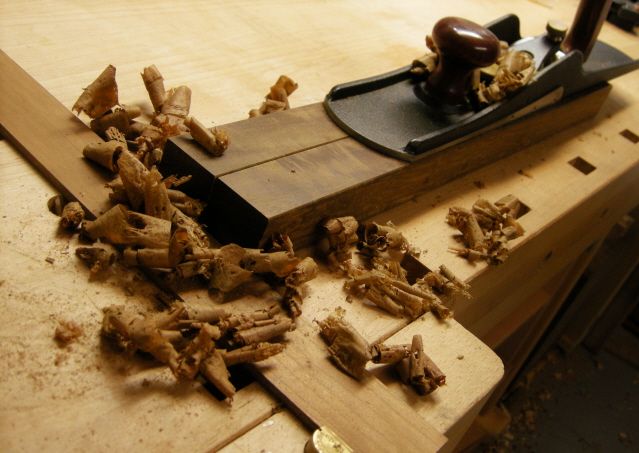
Fidgen builds a frame for his sharpening bench. Read parts one, two, three, five, six, and seven for more details on this project.
Dimensioning Stock and Lay out
I mentioned in the first post that I’m using some ‘off the shelf’ hardwood for the bench frame; this was great for my budget but not ideal for my hand tools. Because it was ‘dimensioned’ at the mill (and I use that term very loosely) I have to re-dimension it all again before I can start laying out my joinery. They’re definition of square must be a little different than mine!
The Ipe is an extremely dense South American hardwood and is very unforgiving to hand tools- perfect irony isn’t it? Here I am making a new sharpening bench and the wood species I’m using is ripping the edges off of my plane irons so fast that I’m going back and forth to my old sharpening area being reminded with each pass how much I’m looking forward to having this new one! Some strange motivation I suppose?
With that I begin planing and dimensioning, sharpening and planing some more. The reverse grain is very unusual in this species, its tones and weight are similar to teak but the dust coming off of it is ‘Kermit the frog green’…If you’re ever using Ipe with power tools make sure you wear a mask! I’m finding the small amount of dust coming off while hand planing a little irritating to my nose and throat. When I have all of the frame components cross cut to length (including joinery) and all surfaced, I can begin my layout.
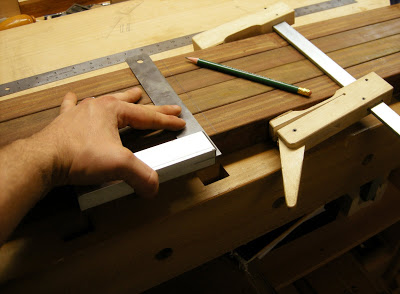
Whenever possible I like to lay out my joinery in groupings ie: the legs get clamped together and the mortises for the cross stretchers are laid out together. This will help keep things consistent and insure continuity between the pieces. I use a pencil to mark off the thickness of each component and then a deep scribe line with my knife for the joinery.
Mortise and Tenons
All of the joinery for the bench frame is mortise and tenon except the front legs into the top apron by way of the slip joint.(refer back to part 3) The Ipe is close to 1 1/2″ square so I’ll follow the rule of thirds and lay out 1/2″ mortises. I begin at the top of the back legs where they meet the bench top. I saw a tenon into the rear leg tops and chop out the mating mortises. Over in my shoulder vise I get out my favourite back saw and make some dust. You may notice in the pictures my set up for sawing the tenons- I hold them in the tail vise and have my bench hook next to it on my bench top. This is an efficient set up when you have a lot of tenons to cut. I start by ripping down the two cheeks and then turn the workpiece and rip the other two shoulder cuts. Then it’s a simple matter of unclamping and sawing at the bench hook without ever having to take a step. I’ll get both tenons cut and then back into the tail vise to pare down to the scribe lines.
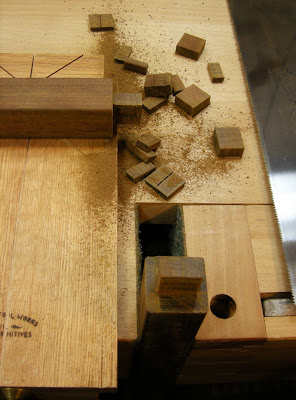
I’ve heard some woodworkers say you should saw ‘right to your scribe lines’ and I suppose in a perfect world this is true. I unfortunately live a few blocks East of a perfect world so I try to leave a bit of material to pare away to. This is especially true on the cross cuts where I want a crisp shoulder line.
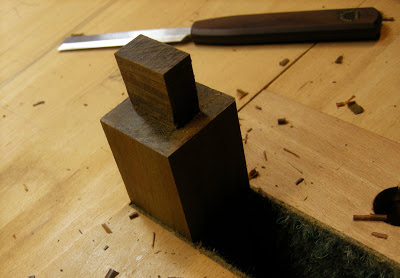
With the tenons cut I’ll forget that measuring tapes were ever invented and use the actual work piece to lay out my mortises. Again, I begin with a pencil and mark out my perimeter and follow with a knife line to determine the actual mortise size.
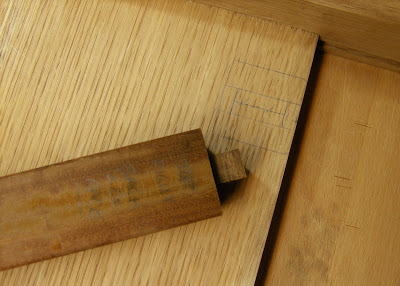
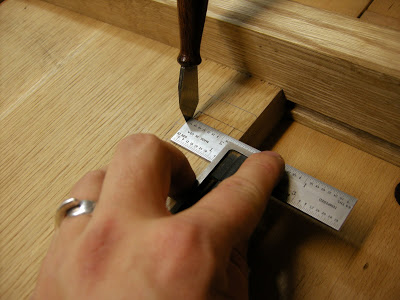
I begin with a brace and bit and bore out the bulk of the material. These are relatively shallow, stub tenons so I trust my eye and bore down into the oak. For deeper tenons I’ll wrap a piece of tape around the bit to show me the finished depth and for really special work pieces I’ll actually make up a wooden ‘collar’ that slips over the bit creating a built in depth stop. But as mentioned, today I’m using my eyes.
From there I’ll use my mortising chisel to chop off the little ‘wings’ left between auger bit holes and square up the ends. I’ll clean out the bottom and get ready for a dry fit. The brace and bit method of cutting mortises is a fast and accurate method but I should also mention when you first lay out the mortise it’s a good idea to scribe in a center line. This will give a point of reference for the bit to find center when drilling. The first dry fit shows me that I need to remove a little meat off of the tenon. This is another one of those wood working myths– tenons don’t have to look pretty!
I know we see them in our favourite woodworking magazines, all crispy and shining like a new dime but really-?
They do need to be straight and they really should be square but besides that they can be as rough as you make ’em. Keeping that in mind I use a rasp to trim the tenons.
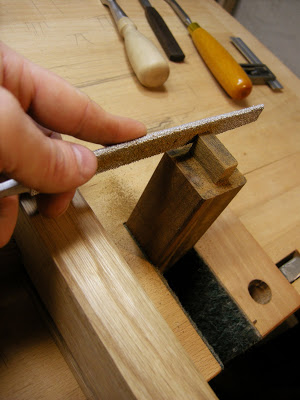
It’s fast and easy and all of those ‘scratch marks’ left behind will actually make for a better glue joint. Another dry fit and it’s on to the next one.
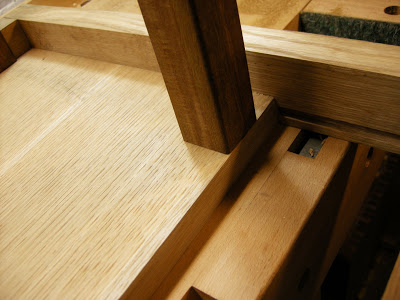
The bench now has four legs standing proudly, although still inverted on my bench top- I decide to address the bottoms of the legs and the feet. It’s a natural progression, but I don’t give the sequence too much thought. I suppose you could cut all of the legs first and then move onto all of the stretchers… I enjoy watching a work piece come together and at the end of my work day I like to see what I’ve accomplished. So I started with the legs and then onto the feet; at least I’ll be able to stand the bench upright and get a sense of where things are going for tomorrow!
The process of cutting the mortise and tenons throughout the frame is pretty much the same system as described above. Pencil to scribe lines and then bore out the waste and…..what’s that? The wood? Too hard?
Oh yeah, I almost forgot- the crazy-dense exotic wood from South America proved to be a little too hard for my auger bit so I wasn’t able to remove the waste like I did in the Oak. Imagine, the quarter sawn white oak in the bench top is actually the ‘friendlier’ softer wood! That’s saying a lot.
So instead of removing the waste with my brace and bit I resort to the crashing and bashing of the mortise chisel. It actually went pretty quickly. As hard as this wood is, it works pretty well and while chopping across the grain for the mortises, I exploited the brittle under tones of the Ipe. The tenons were done as described and before I knew it the legs and the feet are complete…at least for tonight.
Next time I’ll shape the feet and finish the frame. Stay tuned…
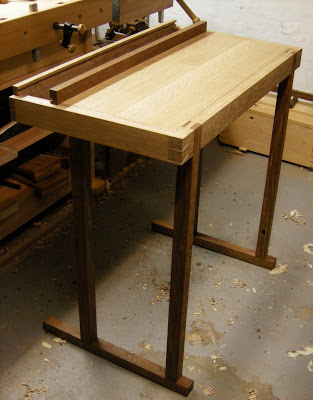

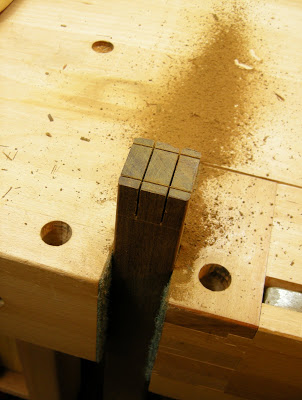
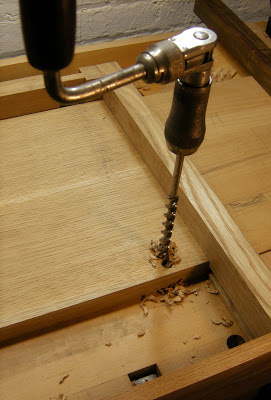

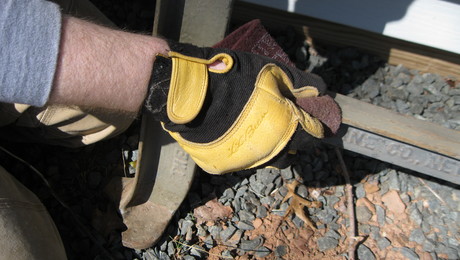
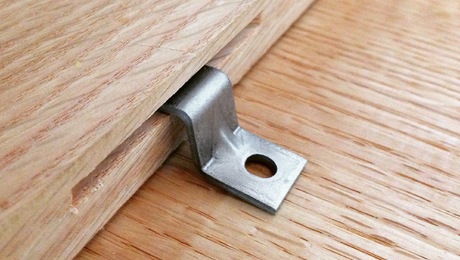
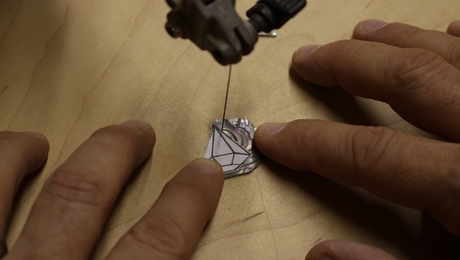


















Log in or create an account to post a comment.
Sign up Log in